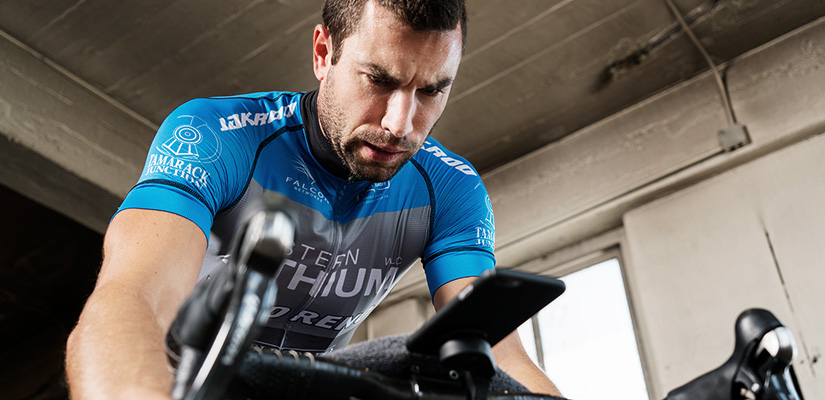Recovery Intervals: The Important Role They Play In Making Cyclists Faster

Ever wonder about recovery intervals? The purpose they serve, the durations they last, even the intensities they’re prescribed at? You’re not alone…
We had the same question, and so we talked about it in depth on episode of 114 of the Ask a Cycling Coach podcast. Here’s an expansion of that discussion.
Furthering performance capabilities by capitalizing on training stimulus and recovery is the essence of structured training. And structured interval workouts are uniquely composed of two main parts: “work” intervals and “recovery” intervals. Athletes get faster by targeting specific energy systems through this distinct balance of work and recovery in each and every workout.
Why Do Workouts Have Recovery Intervals?
At the foundation of structured training is the idea of overload. The overload principle of training supposes athletes prompt physiological adaptations by gradually increasing training stress throughout training cycles. Inducing physiological changes then promotes improved performance capabilities. But performance capabilities are largely dependent on an athlete’s capacity to regenerate the energy required for the exercise itself.¹ Workouts are designed with a careful balance of work and recovery to gradually increase that capacity, and as a result, the ability to repeat/sustain efforts. So there’s two things working: replenishing energy stores and renewing motivation. Enter recovery intervals…
The Science Behind Recovery Intervals
Recovery intervals within a workout are alternated with work intervals to extend the duration of work at supramaximal intensities “and to maximize the biochemical and genetic adaptations that favor performance”.² The duration and intensity of the work intervals directly influences that of the recovery intervals, and workouts are designed individually to increase our capacity to recuperate the energy necessary for particular performance capabilities. The goals of the workouts are changed by the structure of recovery intervals as much as work intervals themselves.³
What Classifies as a Recovery Interval?
Recovery intervals within a structured workout are arranged to provide physiological and psychological relief after a higher-intensity effort that precedes it. The type and extent of relief adjusts based on the duration and intensity of the intervals to tax the aerobic and anaerobic pathways in different ways.4 Which of these metabolic pathways is what the recovery intervals and work intervals combine to dictate.
There are two types of recovery methods within interval work: passive & active recovery.
- Passive recovery: refers to completely resting from exercise within recovery intervals
- Active recovery: refers to a period of recovery where athletes continue a reduced intensity effort which offsets a higher-intensity effort that precedes it. By continuing to engage the muscles at lower-intensities, the body adapts for better shuttling and reuse of metabolic byproduct.5
TrainerRoad’s structured workouts prescribe active recovery strategies which “consist of maintaining submaximal work after fatiguing exercise with the aim of preserving performance level between events”.²
How to Modify Recovery Intervals
Just as work intervals afford a bit of wiggle room, so do recovery valleys. But in the same way that changing work intervals too drastically can alter the intent and outcome of a workout, so too can the manipulation of your recovery intervals.
How important is the prescribed intensity of recovery intervals?
- Some workouts place more importance on the body’s ability to replenish the energy stores to complete the efforts where others focuses on the ability to repeat them with little rest. In both cases, active recovery at prescribed intensity is advised unless it’ll hamper the ability for you to perform the work intervals that follow. That is when you can decide to backpedal or stop pedaling completely to maintain the quality of the remaining intervals.
Can I use passive or active recovery during recovery intervals?
- Research reveals total training stress only marginally increases with active recovery compared to passive recovery.4 So if you can spin during recovery intervals and still be productive in the intervals that follow, we suggest active recovery. If performing the recovery interval with active recovery means hampering the productivity of intervals that follow, try backpedaling or employing passive recovery during that interval.
- The bigger concern with backpedaling is missing the early seconds of short, explosive intervals where every second counts. If you choose to take a short period of passive recovery, crank things up slightly before the beginning of the next work interval to nail the whole thing.
Low- & High- Intensity Recovery
- Low-intensity recovery is set between 40-50% of FTP to allow physiological replenishment and psychological relief. In this process, the body facilitates the processing of metabolic byproducts which replenish fuel stores that are utilized in work intervals that follow.5
- Higher-intensity recovery intervals are aimed more at specialized performance capabilities. In particular racing disciplines, athletes are faced with sustaining or repeating efforts. The structure of recovery intervals reflect this. They are set at higher intensities to maintain a high level of oxygen uptake while simulating the demands of racing. Higher-intensity recovery is more common in workouts seen in Specialty phase training.

Wolfjaw is an example of a workout that includes higher-intensity recovery intervals. This workout includes 6 sets of ~4.5 minute intervals with 7×20 second efforts at 125% FTP. The higher-intensity recovery intervals, or “floats”, last 15 seconds at 88% FTP. Additionally, 5 minute recovery valleys separate each set. This exemplifies a race simulation that includes higher-intensity recovery intervals to face riders with the unrelenting demands on the aerobic and anaerobic systems.
Workout Examples
The following section includes examples of workouts that target each energy system and illustrates how recovery intervals change accordingly.
Zones: Endurance

Maclure consists of 3 hours of riding between 60-70% FTP. Aimed at building aerobic power and efficiency, workouts like these are void of recovery because the goal is continuous, low-intensity stress on slow-twitch muscle fibers. But if the quality of the workout begins to degrade, a 10- to 20- second period of backpedaling can bet things back on track without compromising the workout objectives.
Zones: Tempo

Matanuska is 4×20 minutes of riding spent between 78-90% FTP aimed at improving aerobic power capabilities in a slightly higher but still low stress manner where the energy demand becomes slightly more anaerobic. This workout too targets gradual fatigue of more fatigue-resistant muscle fibers but includes more sizable recovery intervals due to the slightly higher intensity.
Zones: Sweet Spot

Monitor is 6×6 minutes of riding between 88-94% FTP. Aimed at increasing muscular endurance with an pretty even split between aerobic and anaerobic stress, the recovery intervals last 2 minutes at 40% FTP to further the body’s ability to clear metabolic buildup, replenish energy stores, and break from the rigors of higher-intensity work intervals.
Zones: Threshold

Palisade is composed of 5×9 minute intervals where each 1-minute effort at 95% is followed by a 2-minute effort at 105% FTP. Workouts like this one are aimed at increasing muscular endurance as well as enhancing the ability to handle changes in high-level pace. The 2 minute higher-intensity “recovery” intervals following the efforts at 105% aim to increase the body’s ability to recycle the metabolic byproducts from the earlier efforts and use them as fuel.
Zones: V02Max

Spencer is a single set of 5×3-minute intervals working at 120% FTP aimed at increasing suprathreshold power capabilities over greater durations. The recovery intervals are each 3-minutes at 40% FTP to allow the muscles to thoroughly replenish glycogen stores for work intervals that follow. As athletes progress towards more discipline-specific training in the Specialty phase, the recovery valley durations often shrink to simulate the demands of that discipline.
Zones: VO2 Max/Anaerobic

Bashful -1 is 3 sets of 5×1-minute intervals at 125% FTP. Aimed at improving anaerobic power and the ability to repeatedly operate at it, the recovery intervals are 2 minutes long with 4 minute recovery intervals between each set. Increasing anaerobic work capacity is the name of the game in high-power workouts like this with relatively long, low-intensity recovery intervals.

Bashful +1 is 3 sets of 7×1-minute intervals at 125% FTP. Aimed more at improving the ability to operate at high aerobic work capacity with minimal rest between intervals, the recovery intervals are a fraction of the duration of work intervals that precede and follow. The recovery duration between intervals is reduced making the goals of each set all about aerobic “clean up”. The aerobic system is tasked with recycling metabolic byproduct making this a focus on aerobic work capacity in high-power workouts like this. The short, low-intensity recovery intervals between sets share the common aim of replenishing energy stores and providing a psychological break from the hard work.

Wynne is a mix of efforts starting at 130% FTP and rising all the way up to 180% bent exclusively on increasing anaerobic work capacity. By allowing almost excessive recovery, the quality of each highly intense work interval remains high and the workout’s anaerobic objectives are more easily achieved.

Berryessa is a handful of very short, very intense muscular recruitment intervals, a.k.a. sprints, way up at 200% FTP that are only 20 seconds each. The recovery intervals between each sprint are extremely long compared to the preceding work interval indicating that, once again, the focus is on the quality of each high-power repeat with high priority placed on fatigue removal.
Summary
The goals of your workout will be the deciding factor in how important it is to adhere to the intensity of recovery intervals. Workout design isn’t confined to just the carefully crafted “work” intervals—you’re also addressing workout objectives in the periods of recovery as well. In fact, recovery intervals are as prearranged as the intervals that precede them.
Learn More About The Principles of Recovery Intervals
To hear more of your cycling training questions answered, tune into the Ask a Cycling Coach podcast presented by TrainerRoad. New episodes released weekly.
References
- Gastin PB., (2001). Energy system interaction and relative contribution during maximal exercise. https://www.ncbi.nlm.nih.gov/pubmed/11547894
- Hausswirth, Christophe, and Iñigo Mujika. Recovery for Performance in Sport. Human Kinetics, 2013.
- Ross, A., Leveritt, M., (2001) Long-term metabolic and skeletal muscle adaptations to short-sprint training: implications for sprint training and tapering. https://www.ncbi.nlm.nih.gov/pubmed/11735686
- Billat, VL., Slawinski, J., Bocquet, V., Demarle, A., Lafitte, L., Chassaing, P., Koralsztein, JP., (2000) Intermittent runs at the velocity associated with maximal oxygen uptake enables subjects to remain at maximal oxygen uptake for longer time than intense but submaximal runs. https://www.ncbi.nlm.nih.gov/pubmed/10638376
- Gladden, LB., (2004) Lactate metabolism: a new paradigm for the third millennium. https://www.ncbi.nlm.nih.gov/pmc/articles/PMC1664920/
